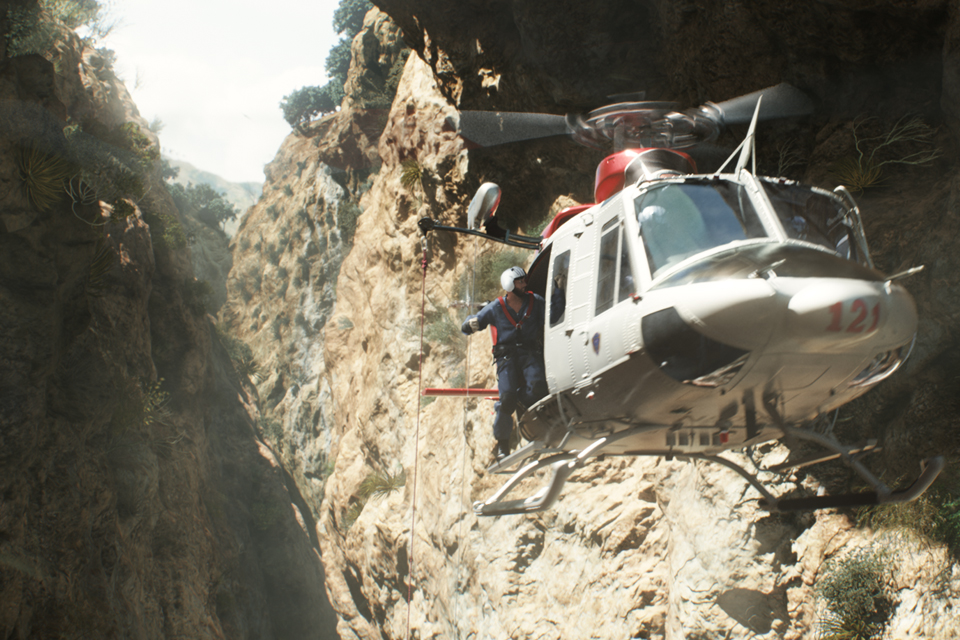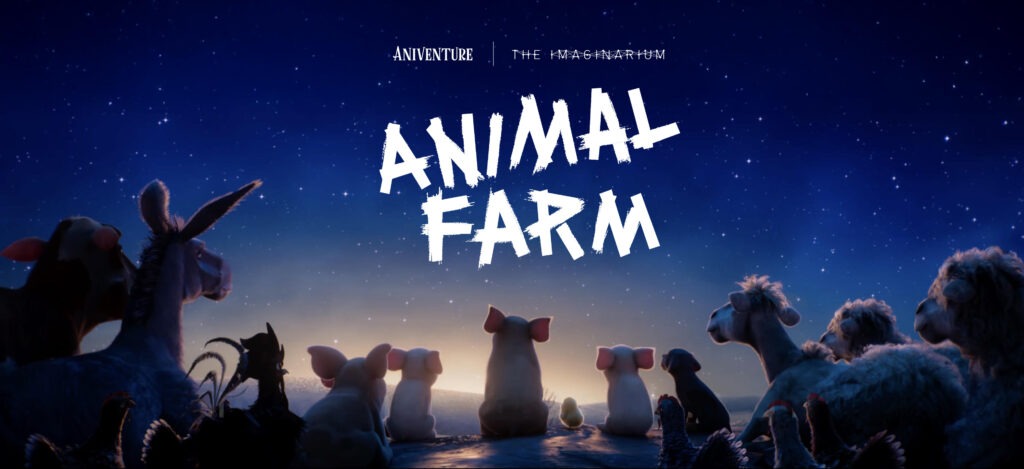
POST MAG: Cinesite Shakes Things Up for San Andreas
Last summer, Into The Storm followed a series of tornadoes as they wreaked havoc across the town of Silverton, OK. This summer, Warner Bros. Pictures takes on the disaster film genre with director Brad Peyton’s San Andreas (starring Dwayne Johnson) that looks to be shaking up the box office as the weekend numbers winner and perhaps ending up as one of the season’s big Hollywood VFX flicks.
The film, which takes place during one of California’s worst earthquakes in its history, features a rescue-chopper pilot (Johnson) making a dangerous journey across the state in order to rescue his wife and daughter. In order to create the realistic opening scene of the film, which involves a young woman driving on a road alongside a mountainous cliff, only for her car to go over the edge during the first earthquake, visual effects supervisors Colin and Greg Strause called on the creatives at UK-based Cinesite. Here,Post speaks with Cinesite VFX supervisor Holger Voss about his studio’s set extension and CG work in this key sequence.
POST: How many VFX shots did you create for the film?
VOSS: “We did 160 — It was a lot of CG. Every shot had to have mist in it and flying debris. It was a lot of work, but once you figured out one shot, it was like another 150 of the same kind, really.”
POST: You were working with visual effects supervisors Colin and Greg Strause, correct?
VOSS: “Yes, the way it happened was, they were on location in Australia, shooting many of the greenscreen scenes and they needed a supervisor for the LA aerial shoot for the same sequence. That’s how we got involved.”
POST: You were shooting aerial footage from a helicopter and cranes? Were you using drones at any point, too?
VOSS: “No, and that was the problem. At that time, I don’t think California had an allowance for commercial use of drones. I don’t know if that has changed, but it would have been very beneficial. We did some aerial shots, the helicopter flying through the canyon, but there were a lot of scenes where the set piece was shot in Australia and we were basically shooting the scenery for it. Since they were shot with a techno-crane, or some type of crane, it’s really hard to mesh them all so what we ended up doing, to cover ourselves, was to shoot tons of stills out of the helicopter and also from the ground up so we could actually recreate the whole environment in case the plates wouldn’t line up. That’s actually what we used most of the time. The scene depicts one side of this canyon, where the actual car crash was, and then the other side of the canyon, which didn’t even exist. We had to find a cliff we were building in CG anyway, so it turned out in the end that it was so much easier to do both sides digitally and just put the greenscreen element on it and that was it.”
POST: This is one of the key scenes in the film and one of the key sequences that Cinesite worked on?
VOSS: “Basically, it’s a continued sequence. It’s the opening sequence of the film. It’s a girl driving in a car and she’s driving through mountain roads. It’s kind of a hidden hill side, with roads where one side is very steep going down, and then she experiences a landslide hitting her car and then the car tumbles off the rode, through various environments and gets stuck in this canyon. We basically cut to this which gets the call to rescue this girl, and as soon as she’s in the helicopter, that’s the end of our sequence.”
POST: So, it was the cliff in particular, and it’s my understanding that the helicopter was also CG?
VOSS: “Yes and no. Obviously there was the plate helicopter that was shot for like air shots and the head piece helicopter that was shot in Australia that we had to put rotor blades on, and exhaust fume and stuff like that, and then there were full CG shots where it was just a full CG helicopter. Sometimes with pilots and a whole crew as well.
In the first sequence, it was a combination, some shots was a real car, that was hidden by a CG landslide, so we had to do the CG landslide, CG mountains and the left-hand side of the car that got hit by rocks had to be replaced. Quite a few shots; it was just a CG car and a CG girl. That was the main work.”
POST: Were there matte paintings involved?
VOSS: “Well, for the canyon, actually, we went down the route of fully building a CG environment because we had to cover so many angles that we felt like doing a matte painting for every angle wouldn’t really work. We had to have animated vegetation in it from the wind of the rotors basically, so for that environment, we didn’t do so much matte paintings. But, when the car goes off the road and it tumbles down, there was a lot of matte painting work in that area.”
POST: Was there anything particularly challenging about the sequence for Cinesite?
VOSS: “The one shot in the opening sequence where the car goes over the cliff. It was meat to be shot in-camera, but the stunt guy couldn’t really do it, and then last minute on the day, we heard we had to do it CG. And, it was meant to be a slow-motion shot and the camera punches in on the windscreen and you see the girl screaming. All of that had to be digital. So that was really challenging.
“In the end, the editor decided it should play realtime, so when you see it in the movie, it doesn’t look all that challenging anymore. But really, it was quite a tricky shot.”
POST: What tools were you using to help you accomplish these shots?
VOSS: “We have a pretty standard pipeline. For tracking, we use 3D Cordova and Maya for our extended CG package. A lot of modeling is done in MatchBox, and then rendering in V-Ray into Nuke. The only thing that was kind of extensively used, which is not always the case, was Agisoft PhotoScan for photogrammetry processing to light up all the pictures.”
POST: Was the work you did on this film unique or different from other projects that you’ve worked on?
VOSS: “Not necessarily. I think what was really the challenge here was that it shouldn’t look like visual effects. It needed to look like you shot most of these shots in a real canyon. So, the challenge was making it more convincing. But technology wise, it was not that tricky.”
POST: If there was one thing that you would credit with how realistic the sequences came out, what would it be?
VOSS: “I think our vegetation was actually quite successful. We dragged in a lot of [CG] bushes and plants everywhere. It’s not that noticeable, but it’s a few thousand plants sometimes and I think it was a big step forward.”
POST: What was the footage shot on? What was the format?
VOSS: “It was all [Arri] Alexa. Shot anamorphic. Pretty standard. Some of the aerial footage was shot on [Red] Dragons. It was standard Alexa resolution of 2.88k anamorphic.
“What was different for us was that the client, for the first time, decided to do a full linear workflow. Not like in the film days where everything was log and you render in CG linear, you comp it all in log and then you give it to the client back in log, which is kind of a legacy thing based on the fact that the scanner produced logarithmic images. So in this case, everything came in linear and went out linear. It’s not a huge difference actually, it’s just the first time we had this workflow.
“I think one of the biggest challenges was that most of the show had to be done in Canada, in our new office. For some of the more complex stuff or data I/O we decided to do it in London, so we had to deal with, ‘how do we work with a different facility’ or ‘how do we interact?’
“I was first meant to do the show in London, and there was a change and it had to be done here and I should supervise it from London and then I ended up actually going to Montreal to supervise it from here.”
POST: How were you sharing the files? Were you using a shared server?
VOSS: “Yes, it’s fully synchronized. Everything we publish shows up in both facilities. It’s more or less seamless, but it also raises some questions, ‘how do you do reviews,’ ‘how do you talk to artists,’ you can’t do rounds and just look over their shoulder and discuss stuff with them. It was an experience because you have to work much more organized than you do when you can actually go to people and talk to them quickly.”
POST: How long ago did your Montreal studio open?
VOSS: “Maybe a year and four months? It was only a few months old when we started.”
POST: Anything you want to add about any scenes you’re particular pleased with how they came out?
VOSS: “You’ll see (laughs). I think it’s good work.”

